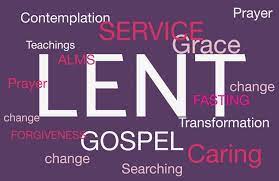Ash Wednesday
Wednesday 14 February is Ash Wednesday, the first day of the season of Lent. It is designated by the Church as days of fast and abstinence, as is Good Friday. The practice of fasting and abstinence aims at leading us to interior conversion by making us more disciplined and more charitable. We fast in order to share our time and our treasure with an attitude of love towards God and others. In addition, the practice helps us imitate the example of Jesus who fasted for 40 days in the desert. The ashes that are marked on our foreheads on the 1st day of Lent are a symbol of humility, purification & sorrow & remind us of the need to repent our failings.
Lent
The name ‘Lent’ comes from an old English word meaning ‘to lengthen’. It was used to describe the 6-week period leading to Easter, because in the northern hemisphere it coincided with the time when the short winter days were gradually growing longer. Lent began as a brief period of preparation for those adults who were to be baptised at Easter. Eventually the rest of the Community also observed an intense period of prayer and fasting before Easter. When adult baptism became the exception rather than the norm, Lent changed from focusing on preparation for baptism or renewing one’s baptismal promises to being an intensely penitential period. The second Vatican Council restored the balance by describing Lent as being marked by two themes, the baptismal and penitential. For those who will be baptised at Easter, Lent is a period of intense preparation called the “Period of Purification and Enlightenment”. Together with those who are preparing for Christian initiation at Easter, we all look to a deeper conversion of heart during the weeks of Lent.
Symbols of Lent – Ashes
In the Jewish scriptures, ashes often suggest humility and human insignificance, as in the familiar “ashes to ashes, dust to dust”. Ashes were also used as a purification offering to ritually cleanse the unclean and also to express mourning and sorrow. We continue the Jewish understanding of ashes as a symbol of humility, purification and sorrow when we are marked with ashes on the first day of Lent. It is a sign of our willingness to cleanse our heart through prayer, fasting and self-denial.
Cross
The cross is the primary symbol of Christianity and a central object in Catholic liturgy. The cross represents victory over death and salvation from sin. During Lent, the cross leads the procession on Palm Sunday, is the focus of Stations of the Cross, and is venerated on Good Friday.
Purple
Purple or violet is the prescribed liturgical colour for Lent. Purple is associated with mourning and so anticipates the pain and suffering of the crucifixion. Because it is the royal colour, it also celebrates Christ’s resurrection and sovereignty. Purple vestments and hangings in Lent visually evoke a mood of simplicity and austerity, so added symbols are unnecessary and distracting. The colour is the symbol.
Lent Liturgical Texts
Some of the Mass prayers that we hear during Lent remind us about the purpose of this season of the Church’s year and provide material for our personal prayer during the week.
“For by your gracious gift each year your faithful await the sacred paschal feasts with the joy of minds made pure, so that, more eagerly intent on prayer and on the works of charity, and participating in the mysteries by which they have been reborn, they may be led to the fullness of grace that you bestow on your sons and daughters.”Preface of Lent I (The spiritual meaning of Lent).
“For you will that our self-denial should give you thanks, humble our sinful pride, contribute to the feeding of the poor, and so help us imitate you in your kindness.”Preface of Lent III (The fruits of abstinence).
“Bless, O Lord, your people, who long for the gift of your mercy, and grant that what, at your prompting, they desire they may receive by your generous gift.” Prayer over the People Fifth Sunday of Lent
The Prefaces of Lent
The first section of the Eucharistic Prayer at Mass – the part that comes after our response “It is right and just” and before the “Holy, holy” – is called the Preface. There are 97 Prefaces in the Roman Missal. The common tone of all these Prefaces is one of thanksgiving. In addition, during feasts and seasons of the church year, the Preface always reflects the focus of the celebration. The Prefaces for the Sundays of Lent serve to reinforce the Gospel readings of the day. For example, the Gospel reading on the second Sunday of Lent is always the account of the transfiguration of Christ on Mount Tabor, so in the Preface on that day we hear:
For after he had told the disciples of his coming Death, on the holy mountain he manifested to them his glory, to show, even by the testimony of the law and the prophets, that the Passion leads to the glory of the Resurrection. (Preface— 2nd Sunday of Lent)
If we are distracted and our thoughts wander, the Preface can sometimes be over before we are aware of it. This is a pity. Listening carefully to the Preface helps us link the Liturgy of the Eucharist at Mass with the Liturgy of the Word .
The Way of the Cross
Stations of the Cross is a popular practice in parishes during Lent. This form of devotion arose after pilgrims began to visit the Holy Land from the end of the 4th century to follow the path that Jesus trod in his last week of life. Christians who were unable to travel to Palestine themselves reproduced a parallel devotion at home. The Franciscans popularised the practice during the Middle Ages, but the number and subject of the stations was not settled until the 18th century. The fourteen stations that were established were a blend of biblical and legendary material. There is no set way of praying the Stations and the Church has never provided an official ritual for the celebration. During Lent, you are invited to walk the Stations on a Friday morning after the 9.00am Stella Maris Mass or alternatively, at 6pm every Friday evening at St Catherine’s, Sippy Downs.
Share This Post:
Recent Releases
Latest Parish News
Whitsunday Next weekend, we celebrate the feast of Pentecost (also called Whitsunday or Whitsun. Pentecost takes place…
NET Report
NET Team update As a team, we’ve been kept busy with lots of Siena Catholic College and…
Reflection – Sixth Sunday of Easter
The Beatles song of the same title makes it all sound so easy! In John’s Gospel,…
Latest Parish News
Hospitality – everyone welcome! This being the first weekend of the month we always have a special…





